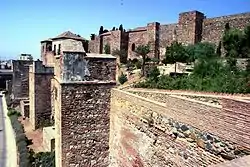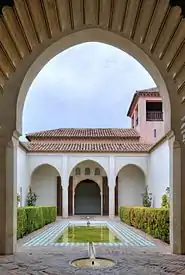Alcazaba
An alcazaba (Spanish: [alkaˈθaβa], Galician: [alkaˈθaβɐ]), alcáçova (Portuguese: [ɐlˈkasuvɐ]) or alcassaba (Catalan: [əlkəˈsaβə]) is a Moorish fortification in Spain and Portugal. The word derives from the Arabic word al-qaṣabah (القَصَبَة), a walled fortification in a city.
History
According to architect restorer Leopoldo Torres Balbás, the Alcazaba of Málaga is the prototype of military architecture in the Taifa period, with its double walled and many fortifications. Its only parallel is the castle of Krak des Chevaliers in Syria.[1]
Alcazabas also are present in Almería, Antequera, Badajoz, Guadix, Mérida, Molina de Aragón, Alcalá la Real and Granada, which is the oldest section of the Alhambra palace.
The term alcazaba should not be confused with alcázar (Spanish) and alcácer (Portuguese), which have their etymology in the Arabic al-qasr, which in turn derives from the Latin castrum, and denotes a fort or castle.



